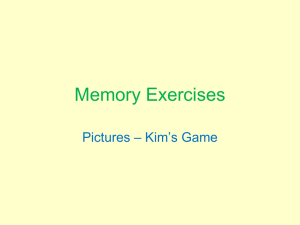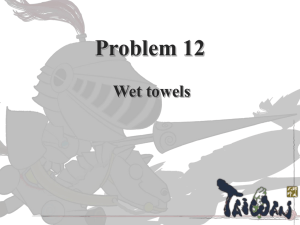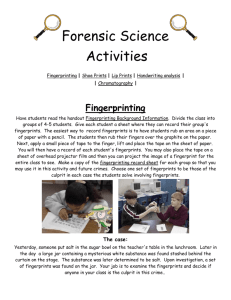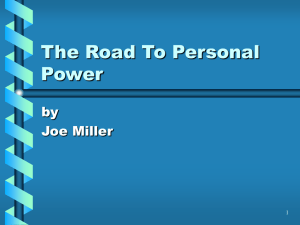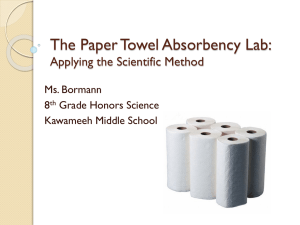File
advertisement
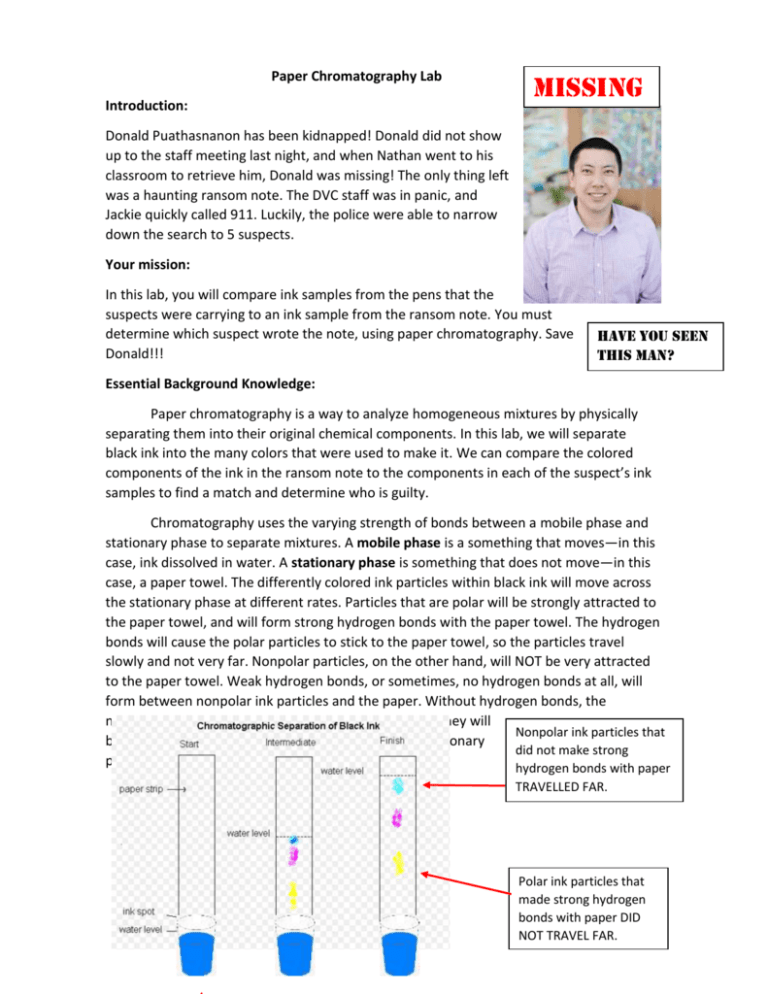
Paper Chromatography Lab Introduction: MISSING Donald Puathasnanon has been kidnapped! Donald did not show up to the staff meeting last night, and when Nathan went to his classroom to retrieve him, Donald was missing! The only thing left was a haunting ransom note. The DVC staff was in panic, and Jackie quickly called 911. Luckily, the police were able to narrow down the search to 5 suspects. Your mission: In this lab, you will compare ink samples from the pens that the suspects were carrying to an ink sample from the ransom note. You must determine which suspect wrote the note, using paper chromatography. Save Donald!!! HAVE YOU SEEN THIS MAN? Essential Background Knowledge: Paper chromatography is a way to analyze homogeneous mixtures by physically separating them into their original chemical components. In this lab, we will separate black ink into the many colors that were used to make it. We can compare the colored components of the ink in the ransom note to the components in each of the suspect’s ink samples to find a match and determine who is guilty. Chromatography uses the varying strength of bonds between a mobile phase and stationary phase to separate mixtures. A mobile phase is a something that moves—in this case, ink dissolved in water. A stationary phase is something that does not move—in this case, a paper towel. The differently colored ink particles within black ink will move across the stationary phase at different rates. Particles that are polar will be strongly attracted to the paper towel, and will form strong hydrogen bonds with the paper towel. The hydrogen bonds will cause the polar particles to stick to the paper towel, so the particles travel slowly and not very far. Nonpolar particles, on the other hand, will NOT be very attracted to the paper towel. Weak hydrogen bonds, or sometimes, no hydrogen bonds at all, will form between nonpolar ink particles and the paper. Without hydrogen bonds, the nonpolar particles will not stick as much to the paper. They will Nonpolar ink particles that be free to move further and more quickly along the stationary did not make strong phase. hydrogen bonds with paper TRAVELLED FAR. Polar ink particles that made strong hydrogen bonds with paper DID NOT TRAVEL FAR. Materials: - 5 pens that the suspects were carrying 5 strips of paper towel 5 clear plastic cups 5 clothes pins a strip of the ransom letter metric ruler water (or other solvent mixture) pencil Procedures: 1. 2. 3. 4. Label the clothes pins #1-5. Draw a horizontal line IN PENCIL 2 cm from the bottom of each paper towel strip. Clip the paper towel strips to a clothes pin. Draw 1 dot of black in the center of your pencil line. Use a different suspect’s pen for each paper towel strip. 5. Fill your plastic cups with water. 6. Clip your paper towel strips to a binder or book so that they are dangling vertically, with the pencil lined end at the bottom. 7. Emerge the bottom tip of the paper towel strips in water. MAKE SURE that the water level is BELOW the pencil line. (The pencil line should not get wet!!) 8. Leave the paper towel strip emerged in water until the water gets absorbed almost all the way up the strip. Remove your paper towel strip from the water when there is about 1 cm of paper left dry at the top. 9. Record qualitative observations. 10. Lay the paper towel strips flat on the table next to the metric ruler. Take a photo of each paper towel strip. 11. Using the photo OR the real strip (pending how much time you have), calculate the Retention Factor (Rf) of each color. Retention factor is the ratio of the distance a particle moved to the distance that the solvent (mobile phase) moved. The Example Rf bigger the Rf, the further the spot moved. Calculation Rf= distance that the color particle moved (cm) distance that the water moved (cm) 12. Clean up all supplies! P r e- l ab Re qu i r em en t s : 1. APA Title Page 2. Typed introduction paragraph: Follow template on project 2 brief (same as murder lab) Background information should include research-based facts about about: - Chemical bonding -hydrogen bonding -chromatography. (How is a hydrogen bond different than other types of bonds? How is hydrogen bonding used to our advantage in chromatography? What other types of chromatography are there? Why is chromatography important and useful?) Make sure that you summarize and/or analyze all research in your own words! Cite all references. Hypothesis: Write as an “If______, then _______” sentence structure. Think about your prediction. How will you be able to tell which ink sample was used to write the ransom note? Sample hypothesis sentence frames: “If the _______ for all present colors in a suspect’s ink sample match the _________ of all colors in the control, then the suspect is most likely guilty. If the paper is (more/less) polar than water, then (polar/nonpolar) particles will separate quickly, while (polar/nonpolar) particles will separate slowly.” 3. Methods paragraph (typed) Do your best! This is a rough draft that you will be able to edit later. It is useful to write it ahead of time to get a jump start on the write up, and to familiarize yourself with the procedure you will be performing. Write it by reading the procedures in this lab and summarizing the key points. When you edit later, be sure to include how many mL of water you put in each cup, the procedure you followed to calculate Rf, controlled/ independent/ dependent variables, and how many trials you performed Name: Date: Per:

